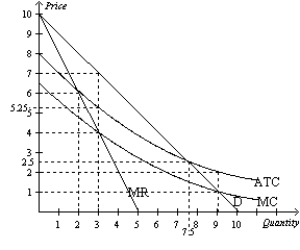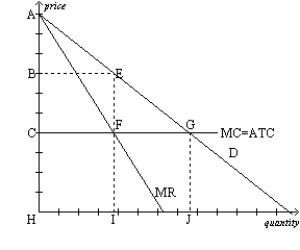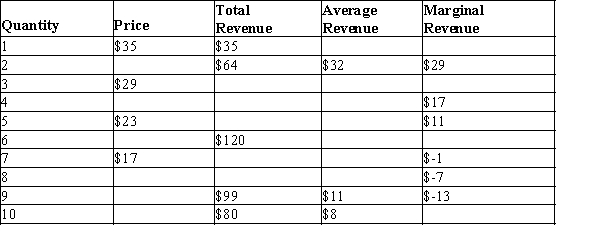A) and a monopolist are price takers.
B) and a monopolist are price makers.
C) is a price taker, whereas a monopolist is a price maker.
D) is a price maker, whereas a monopolist is a price taker.
F) A) and D)
Correct Answer

verified
Correct Answer
verified
Multiple Choice
Scenario 15-6 The concert promoters of a heavy-metal band, WeR2Loud, know that there are two types of concert-goers: die-hard fans and casual fans. For a particular WeR2Loud concert, there are 1,000 die-hard fans who will pay $150 for a ticket and 500 casual fans who will pay $50 for a ticket. There are 1,500 seats available at the concert venue. Suppose the cost of putting on the concert is $50,000, which includes the cost of the band, lighting, security, etc. -Refer to Scenario 15-6. How much additional profit can the concert promoters earn by charging each customer their willingness to pay relative to charging a flat price of $150 per ticket?
A) $25,000
B) $50,000
C) $75,000
D) $100,000
F) All of the above
Correct Answer

verified
Correct Answer
verified
True/False
The supply curve for a monopolist, in the short run, is defined in the same way as that for a competitive firm: it is the portion of the marginal cost curve above average variable cost.
B) False
Correct Answer

verified
Correct Answer
verified
Multiple Choice
When a monopolist maximizes profit, its marginal cost will
A) be less than its average fixed cost.
B) be less than the price per unit of its product.
C) exceed its marginal revenue.
D) equal its average total cost.
F) All of the above
Correct Answer

verified
Correct Answer
verified
Multiple Choice
Which of the following can defeat the profit-maximizing strategy of price discrimination?
A) consumer surplus
B) deadweight loss
C) market power
D) arbitrage
F) A) and D)
Correct Answer

verified
Correct Answer
verified
Multiple Choice
One problem with government operation of monopolies is that
A) a benevolent government is likely to be interested in generating profits for political gain.
B) monopolies typically have rising average costs.
C) the government typically has little incentive to reduce costs.
D) a government-regulated outcome will increase the profitability of the monopoly.
F) A) and C)
Correct Answer

verified
Correct Answer
verified
Short Answer
Figure 15-2  -Refer to Figure 15-2. If the firm profit-maximizes, what amount of output will it produce?
-Refer to Figure 15-2. If the firm profit-maximizes, what amount of output will it produce?
Correct Answer

verified
Correct Answer
verified
Multiple Choice
The amount that producers receive for a good minus their costs of producing it equals
A) quantity supplied.
B) supply price.
C) deadweight loss.
D) producer surplus.
F) A) and C)
Correct Answer

verified
Correct Answer
verified
Multiple Choice
For a monopoly firm, the shape and position of the demand curve play a role in determining the (i) Profit-maximizing price.(ii) Shape and position of the marginal-cost curve.(iii) Shape and position of the marginal-revenue curve.
A) (i) and (ii) only
B) (ii) and (iii) only
C) (i) and (iii) only
D) (i) , (ii) , and (iii)
F) None of the above
Correct Answer

verified
Correct Answer
verified
Short Answer
Figure 15-3  -Refer to Figure 15-3. Which letter represents the profit-maximizing price chosen by the single price monopolist?
-Refer to Figure 15-3. Which letter represents the profit-maximizing price chosen by the single price monopolist?
Correct Answer

verified
Correct Answer
verified
True/False
A monopolist does not have a supply curve because the firm's decision about how much to supply is impossible to separate from the demand curve it faces.
B) False
Correct Answer

verified
Correct Answer
verified
True/False
The amount of power that a monopoly has depends on whether there are close substitutes for its product.
B) False
Correct Answer

verified
Correct Answer
verified
Multiple Choice
Table 15-1  -Refer to Table 15-1. When 4 units of output are produced and sold, what is average revenue?
-Refer to Table 15-1. When 4 units of output are produced and sold, what is average revenue?
A) $17
B) $21
C) $23
D) $26
F) C) and D)
Correct Answer

verified
Correct Answer
verified
Multiple Choice
Which of the following statements is not correct?
A) The government may use antitrust laws to prevent a merger if the government believes the merger will reduce competition and increase prices.
B) By regulating a natural monopoly where price equals average total cost, the monopoly earns zero profits.
C) An advantage of private ownership over public ownership is that private business owners tend to fire inefficient managers.
D) The government should always intervene to improve monopoly inefficiency.
F) All of the above
Correct Answer

verified
Correct Answer
verified
Short Answer
The fundamental cause of monopoly is
Correct Answer

verified
Correct Answer
verified
Multiple Choice
When a monopolist increases the number of units it sells, there are two effects on revenue. They are the
A) demand effect and the supply effect.
B) competition effect and the cost effect.
C) competitive effect and the monopoly effect.
D) output effect and the price effect.
F) B) and D)
Correct Answer

verified
Correct Answer
verified
Multiple Choice
A natural monopoly occurs when
A) the product is sold in its natural state, such as water or diamonds.
B) there are economies of scale over the relevant range of output.
C) the firm is characterized by a rising marginal cost curve.
D) production requires the use of free natural resources, such as water or air.
F) A) and C)
Correct Answer

verified
Correct Answer
verified
Multiple Choice
When we compare economic welfare in a monopoly market to a competitive market, the profits earned by the monopolist represent
A) a loss in total welfare.
B) a transfer of benefits from the buyer to the seller.
C) the higher marginal costs incurred by the monopolists in comparison to competitive firms.
D) All of the above are correct.
F) A) and B)
Correct Answer

verified
Correct Answer
verified
Multiple Choice
Which of the following would be most likely to have monopoly power?
A) a long-distance telephone service provider
B) a local cable TV provider
C) a large department store
D) a gas station
F) A) and C)
Correct Answer

verified
Correct Answer
verified
True/False
If the government deems a newly-invented drug to be truly original, the pharmaceutical company is given the exclusive right to manufacture and sell the drug for 50 years.
B) False
Correct Answer

verified
Correct Answer
verified
Showing 341 - 360 of 662
Related Exams